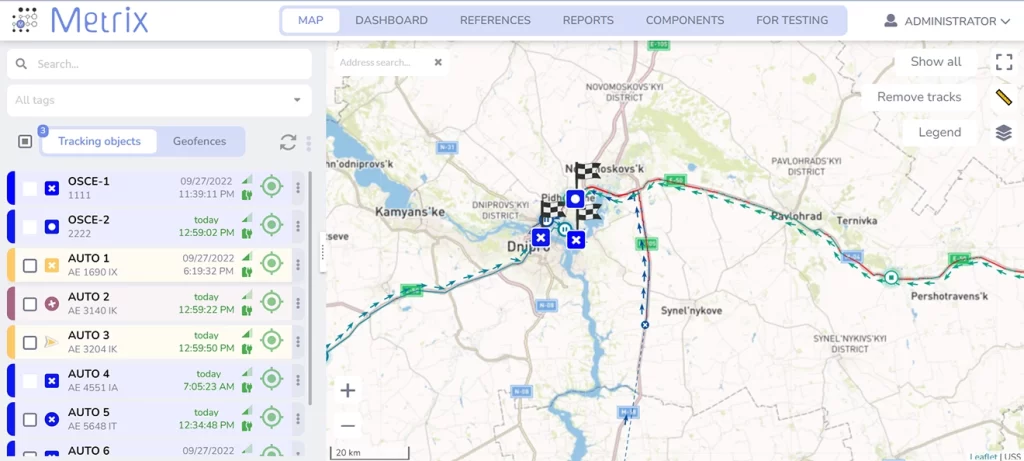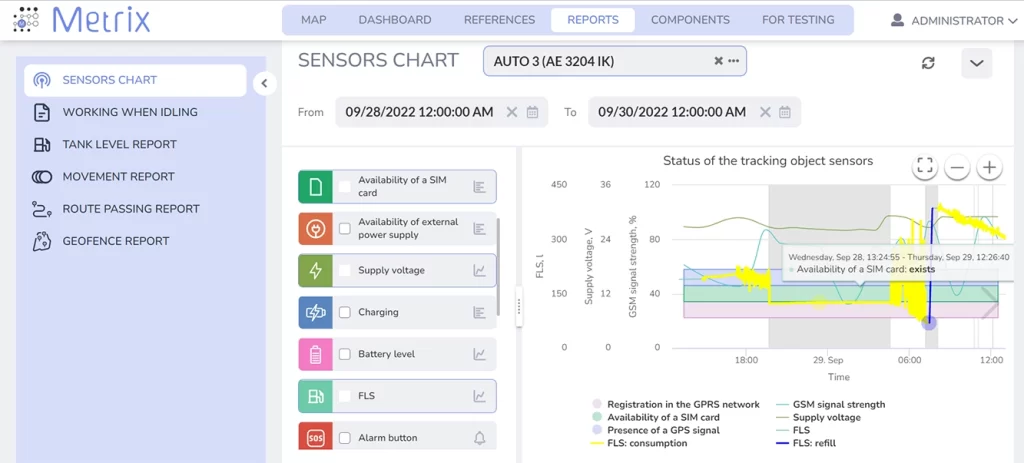IoT-focused GPS track solutions
IoT-based GPS tracking software typically consists of three components: the GPS device or sensor, the wireless network, and the central server or cloud-based platform. The GPS device or sensor is responsible for collecting location data, which is transmitted to the central server via a wireless network such as cellular or satellite communication. The central server then processes this data and provides users with real-time location information, historical data, and alerts based on predefined rules or events.
In addition to location tracking, IoT-based GPS tracking software may also provide other features such as route optimization, geofencing, driver behavior analysis, and vehicle maintenance tracking.
Ways of using IoT in real-time tracking software
Real-time GPS trackers can leverage IoT technology in several ways to enable efficient tracking and monitoring of assets or people.
Here are some ways IoT is used in real-time tracking software:
IoT-enabled sensors
IoT-enabled sensors can be attached to objects or assets to collect real-time data on their location, temperature, humidity, motion, and other parameters. These sensors can be used to track assets in real-time, send alerts when the asset moves out of a specified zone, and monitor the environment around the asset.
GPS tracking IoT
So, how does a GPS IoT tracker work? IoT devices with GPS capabilities can be used to track the location of objects or people in real-time. GPS-enabled devices can send location data to the tracking software, which can display the location on a map and send alerts if the object or person moves out of a specified area.

Data analytics
IoT-enabled devices can collect a vast amount of data in real-time, which can be analyzed to identify patterns and trends. Real-time tracking software can leverage this data to provide insights into the movement and behavior of objects or people being tracked.

Mobile apps
GPS real-time tracking software can be integrated with mobile apps, which can be used to track assets or people in real-time. The app can receive location data from IoT devices and display the location on a map, send alerts, and provide real-time tracking information.
IoT technology can play a significant role in real-time tracking software by providing real-time data, analytics, and insights into the location and movement of assets or people.
Incorporate all the IoT capabilities with our IoT development services. Use all the power of today’s IoT technology to upscale and transform your business.
Reasons for using IoT in real-time tracking software
IoT can be a valuable tool for real-time tracking software for several reasons:
Improved Efficiency
IoT devices can collect and transmit data in real-time, which can be used to optimize processes and workflows, resulting in increased efficiency and productivity.
Enhanced Visibility
IoT devices can provide real-time visibility into the location and status of assets, allowing organizations to track their inventory, monitor their supply chain, and manage their fleet.
Better Decision Making
By leveraging real-time data from IoT devices, businesses can make more informed decisions, react quickly to changing conditions, and optimize their operations for maximum efficiency.
Cost Savings
IoT devices can help businesses reduce costs by minimizing downtime, preventing asset loss, and optimizing resource utilization.
Increased Safety
IoT devices can be used to monitor safety conditions in real-time, alerting workers to potential hazards and helping to prevent accidents and injuries.
The use of IoT in real-time vehicle tracking can provide significant benefits for businesses, including increased efficiency, enhanced visibility, better decision-making, cost savings, and increased safety.
Technologies for IoT in vehicle tracking
IoT-based vehicle tracking systems rely on a combination of hardware and software technologies to provide real-time information about the location and performance of a vehicle. Here are some of the key technologies involved:
Cellular networks
IoT devices in the vehicle use cellular networks to transmit data to a central server or cloud-based platform.
GPS
Global Positioning System (GPS) is used to determine the exact location of the vehicle.
RFID
Radio-Frequency Identification (RFID) technology is used to identify vehicles and track them as they move through checkpoints or gates.
Sensors
Various types of sensors can be used to monitor vehicle performance, such as engine speed, fuel consumption, tire pressure, and temperature.
Cloud computing
Cloud-based platforms are used to store and process the data generated by IoT devices, making it accessible to fleet managers and other authorized users.
Big data analytics
Data analytics tools are used to analyze the vast amounts of data generated by IoT devices, providing insights into vehicle performance and identifying opportunities for optimization and cost savings.
Machine learning
Machine learning algorithms can be used to analyze historical data and predict future trends, such as maintenance needs and potential breakdowns.
Overall, the IoT in vehicle tracking relies on a range of technologies to provide accurate and actionable information to fleet managers and other stakeholders.
How IoT tracking devices work
IoT GPS tracking devices work by using a combination of satellite-based positioning systems and wireless communication technologies to track the location of objects or people in real-time.
Here is a brief overview of how IoT GPS tracking devices work:
- GPS receiver: The IoT GPS tracking device has a GPS receiver that receives signals from satellites in orbit. These signals contain information about the location, time, and velocity of the device, so you get GPS real time information.
- Wireless communication: The IoT GPS tracking device then uses wireless communication technologies, such as cellular networks, Wi-Fi, or Bluetooth, to transmit this information to a server or a mobile app.
- Cloud-based server: The server processes the location data and makes it available for viewing in real-time through a web or mobile application.
- Geo-fencing: Some IoT GPS tracking devices also allow you to set up geo-fences, which are virtual boundaries that trigger an alert if the device moves outside of the designated area.
- Battery: The device is powered by a battery that needs to be recharged periodically.

In general, IoT GPS tracking devices are a convenient and effective way to keep track of the location of assets, vehicles, or people in real-time, allowing businesses and individuals to improve operational efficiency, safety, and security.
Advantages of using IoT vehicle tracking software
There are several advantages of using IoT vehicle tracking software, including:
Real-time monitoring
With IoT vehicle tracking software, you can track your vehicles in real-time. This means you can know the exact location of your vehicles at any given time, which can be very useful for managing your fleet.
Increased efficiency
By using IoT vehicle tracking software, you can optimize your fleet routes and reduce idle time. This can help you save on fuel costs, reduce vehicle wear and tear, and improve overall efficiency.
Improved safety
IoT vehicle tracking software can help improve driver safety by monitoring driving behavior, such as excessive speeding, hard braking, and sudden lane changes. This can help you identify risky driving behavior and take corrective action before an accident occurs.
Enhanced customer service
With IoT vehicle tracking software, you can provide your customers with accurate delivery estimates and real-time updates on the status of their shipments. This can help improve customer satisfaction and loyalty.
Cost savings
By optimizing your fleet routes and reducing idle time, you can save on fuel costs and reduce vehicle wear and tear. In addition, by monitoring driving behavior, you can reduce the risk of accidents and lower insurance costs.
IoT Future for Fleets
The future of IoT for fleets is very promising. The possibilities for fleets looking to incorporate IoT capabilities go far beyond real-time GPS tracking. With the increasing number of connected devices and the advancements in technology, IoT is rapidly transforming the way fleets operate. IoT provides fleets with a wealth of data that can be used to optimize their operations and improve overall efficiency.
One of the most significant benefits of IoT for fleet management is the ability to monitor vehicle health in real-time. Connected sensors can detect issues before they become serious problems, allowing for preventative maintenance and reducing downtime. Additionally, IoT can be used to track fuel consumption, driver behavior, and vehicle location, providing valuable insights that can be used to optimize routes and reduce fuel costs.
Another significant benefit of IoT for fleets is the ability to improve safety. Connected sensors can detect dangerous driving behaviors such as hard braking, sharp turns, and speeding, allowing fleet managers to take action to reduce accidents and improve driver safety.
As technology continues to advance, the future of IoT fleet management will likely include even more advanced features. For example, machine learning and artificial intelligence could be used to analyze data from sensors and provide predictive maintenance recommendations. Additionally, autonomous vehicles could be integrated with IoT sensors to provide even greater levels of efficiency and safety.
Overall, the future of IoT-based fleet management is very promising, and fleets that embrace this technology will likely see significant benefits in terms of efficiency, safety, and cost savings.
Conclusion
In conclusion, IoT-based GPS tracking software is a valuable tool for businesses that want to improve their operations, reduce costs, and enhance customer satisfaction. It is a must-have technology for fleet management, logistics, and supply chain management, and it can help businesses to stay competitive in today's fast-paced business environment. And IoT vehicle tracking software can help you improve efficiency, safety, and customer service, while also reducing costs.
you may also want to read

Leveraging Local LLMs and Secure Environments to Protect Sensitive Information
In the rapidly evolving digital landscape, businesses are increasingly adopting Generative AI (GenAI) technologies to stay competitive and innovate. Large...

Boost Efficiency Today: Easy AI Integration for Immediate Results
In the past, the idea of integrating artificial intelligence into your business might have felt like venturing into uncharted territory—complex,...

A Roadmap to Gen AI Adoption for Small and Medium Businesses
Unlock new opportunities by integrating Generative AI into your business operations. In today’s fast-paced digital landscape, small and medium businesses...
